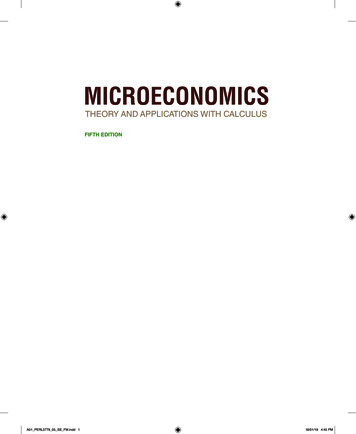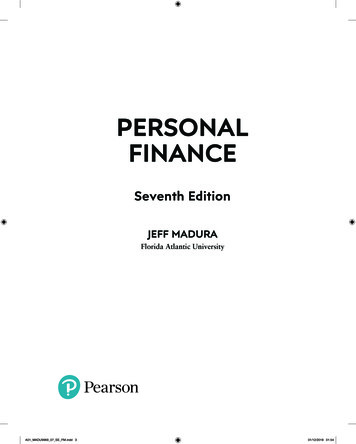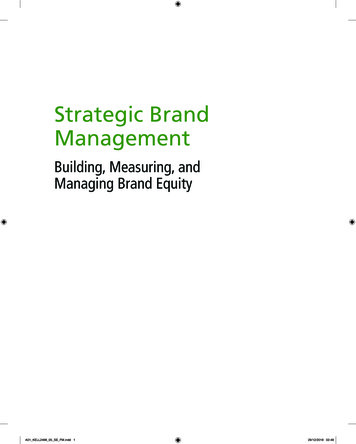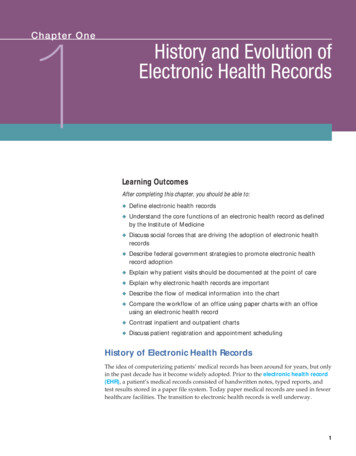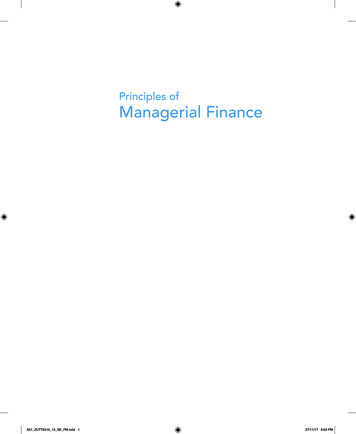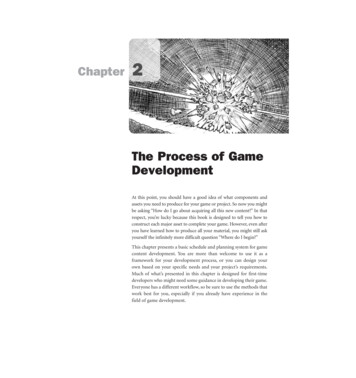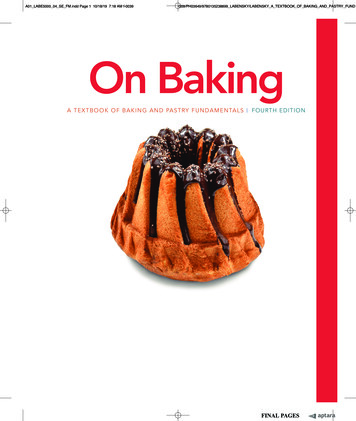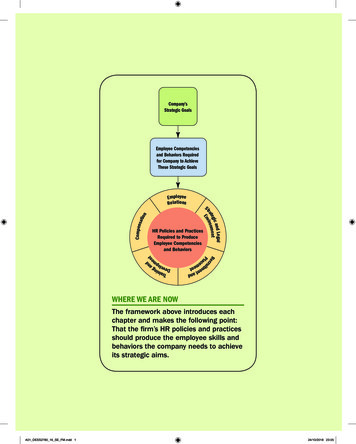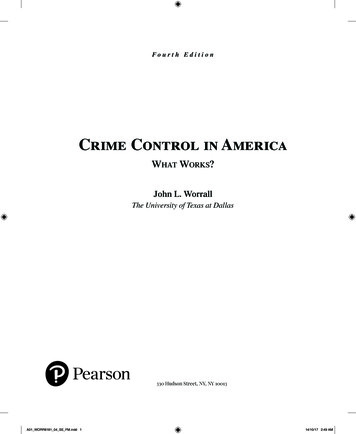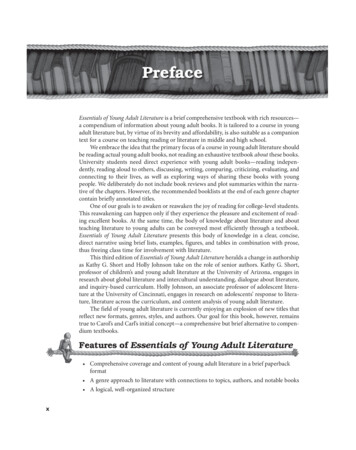
Transcription
PrefaceEssentials of Young Adult Literature is a brief comprehensive textbook with rich resources— a compendium of information about young adult books. It is tailored to a course in youngadult literature but, by virtue of its brevity and affordability, is also suitable as a companiontext for a course on teaching reading or literature in middle and high school.We embrace the idea that the primary focus of a course in young adult literature shouldbe reading actual young adult books, not reading an exhaustive textbook about these books.University students need direct experience with young adult books— reading independently, reading aloud to others, discussing, writing, comparing, criticizing, evaluating, andconnecting to their lives, as well as exploring ways of sharing these books with youngpeople. We deliberately do not include book reviews and plot summaries within the narrative of the chapters. However, the recommended booklists at the end of each genre chaptercontain briefly annotated titles.One of our goals is to awaken or reawaken the joy of reading for college-level students.This reawakening can happen only if they experience the pleasure and excitement of reading excellent books. At the same time, the body of knowledge about literature and aboutteaching literature to young adults can be conveyed most efficiently through a textbook.Essentials of Young Adult Literature presents this body of knowledge in a clear, concise,direct narrative using brief lists, examples, figures, and tables in combination with prose,thus freeing class time for involvement with literature.This third edition of Essentials of Young Adult Literature heralds a change in authorshipas Kathy G. Short and Holly Johnson take on the role of senior authors. Kathy G. Short,professor of children’s and young adult literature at the University of Arizona, engages inresearch about global literature and intercultural understanding, dialogue about literature,and inquiry-based curriculum. Holly Johnson, an associate professor of adolescent literature at the University of Cincinnati, engages in research on adolescents’ response to literature, literature across the curriculum, and content analysis of young adult literature.The field of young adult literature is currently enjoying an explosion of new titles thatreflect new formats, genres, styles, and authors. Our goal for this book, however, remainstrue to Carol’s and Carl’s initial c oncept— a comprehensive but brief alternative to compendium textbooks.Features of Essentials of Young Adult Literature Comprehensive coverage and content of young adult literature in a brief paperbackformat A genre approach to literature with connections to topics, authors, and notable books A logical, well-organized structurexA01 SHOR2273 03 SE FM.indd 101/11/14 1:33 PM
Prefacexi Useful charts and tables on history, research, read-aloud recommendations, andexamples of literature to use across the curriculum Notable author features for the genre chapters Definitions of terms that appear in bold italics Coverage of multicultural and international young adult literature, graphic novels,short stories, novels in verse, and picture books for older readers Clearly stated positions on current issues affecting schools and literature: censorship,classics, and standards Attention to the needs of resistant readers Recommended book lists that are logically organized and briefly annotated Awards recognizing young adult literature with listings of the winning titlesFeatures New to This Edition Hundreds of new young adult books in annotated lists and as examples throughoutthe chapters More integration of multicultural and global titles and authors throughout chapters Discussion of text complexity, close reading, and other aspects of the Common CoreState Standards Research on reading interests and discussion of why reading and literature are at riskin our society moved to Chapter 1 Evaluation and selection criteria in genre chapters revised as questions to facilitatetheir use as an evaluation tool Excellent Books to Read Aloud feature added to the genre chapters Types of fantasy and realistic fiction updated to reflect current trends Plays and readers theatre added as a genre in the poetry chapter Science fiction as a genre Chapter 8, “Literature for a Diverse Society,” revised to highlight the importance ofcritically responsive, critically expansive, and culturally critical approaches toliterature. Previous three chapters in Part Three are reorganized into two chapters Chapter 9, “Literature in the Curriculum,” includes the political context ofCommon Core State Standards, ways of organizing a literature curriculum anddeveloping literature units, and the resources to support this curriculum. Thechapter ends with the critical issues to consider in a literature c urriculum— censorship, classic texts, and literary criticism. Chapter 10, “Experiencing Literature,” begins with a discussion of how to create aliterate environment for all readers, especially resistant readers. Teachingstrategies and literature engagements are organized into three sections: readingwidely for personal purposes, reading critically to inquire about the world, andreading strategically to learn about literature and literacy.A01 SHOR2273 03 SE FM.indd 111/11/14 1:33 PM
xiiPreface Expanded discussion of literature circles and literature response engagementsAdditional emphasis on young adult–classic literature pairingsA discussion of the teaching of literary criticism using young adult literatureNew conceptual planning webs on the forced journeys of refugees and takingresponsibility for action in Chapter 9 Resistant readers addressed in Chapter 10 on experiencing literature through adiscussion of the types of adolescent resistant readers and the integration ofsuggestions for reaching these readers into classroom engagements Technology connections integrated across the chaptersAcknowledgmentsWe are grateful to Aurora Martínez, who made possible the original publication of Essentialsof Young Adult Literature.For their generous help, good advice, and valued opinions concerning Essentials ofYoung Adult Literature, we wish to express our appreciation to the following reviewers:Dr. Leslie Crabtree, North Central University; Dr. Thomas Eaton, Southeast Missouri StateUniversity; Dr. Julie Gates, Angelo State University; Jeffrey Stuart Kaplan, University ofCentral Florida; Amy Walsh MacKrell, Simpson College; Dr. Charlotte L. Pass, State University of New York College at Courtland.We are indebted to illustrator David Wiesner for the cover of this edition of Essentialsof Young Adult Literature. His images of adolescents who are reaching new heights throughliterature capture the potential and the challenge that readers experience as they exploreideas and experiences that take them beyond their current understandings and experiences.A01 SHOR2273 03 SE FM.indd 121/11/14 1:33 PM
Part Oneoung Adults and YoungAdult LiteraturePart One introduces you to the field of youngreading interests, useful selection sources, andadult literature. These chapters will supportways of determining text complexity.you in considering the value of this literature forChapter 2 presents important literature con-adolescents and learning how to select and evalu-cepts, including elements of fiction, fictional liter-ate young adult books, currently the fastest grow-ary forms, and aspects of book format, as theying area in book publishing.connect to young adult literature. The major fic-Chapter 1 begins by defining young adults andtional literary forms of novels and novels in verse,young adult literature as well as presenting an over-short stories, picture books, and graphic novelsview of the history of young adult literature, includ-are also highlighted.ing milestones in the evolution of the field and earlyAlthough examples are given throughout thisimportant works. We discuss the value of this liter-text of well-known young adult books as well asature for adolescents along with research evidencerecent notable titles, lengthy plot summaries orsupporting its benefits for readers and for society.book reviews are not included. We believe thatEvaluating and selecting the best books for adoles-more is gained from reading and discussing thecents involves knowing both readers and booksactual young adult books than from reading aboutand so includes knowledge about adolescentthe books in a lengthy textbook.M01 SHOR2273 03 SE C01.indd 109/01/14 11:02 PM
Chapter OnenderstandingYoung Adults andTheir LiteratureChange is always accompanied by anticipation, anxiety, excitement, andfear, often felt all at the same time. The years between childhood andadulthood magnify these emotions b ecause they are a time of tremendouschange at many levels for young adults as they e ngage in “becoming” andredefining themselves personally, socially, and culturally. Young adults areold enough to be conscious of this change process and so find reassuranceand understanding in the company of those who share their experiencesand feelings. That company includes the people in their lives, some ofwhom are characters in books and the worlds adolescents enter andexperience through literature.M01 SHOR2273 03 SE C01.indd 209/01/14 11:02 PM
Chapter 1Understanding Young Adults and Their Literature3Definitions of Young Adult Literature“Young adult” is a term that has no clear definition, often connoting words such as puberty,adolescence, and teenager, which suggest different things to different people. Even professionals in the fields of sociology, psychology, and education do not agree on the meaningsof these terms. In the United States and most other Western countries, young adulthood isassociated with biological changes and a growing sense of independence from adults.Young adults are seen as evolving through a search for self and identity as they growand change. At some point and for varying economic, social, political, and biological reasons, a child transitions to adulthood, and young adulthood ends. These developmentsoccur at different ages and at different rates for different people, yet the prevalent schoolconfiguration in the United States defines middle school as grades 6 through 8 (ages 11through 14 for most students) and high school as grades 9 through 12 (ages 15 through 18for most students).The dominant ideology of adolescence as a life stage that is biologically or psychologically determined by “raging hormones” has been criticized (Flinders, 1999). Adolescenceis traditionally viewed as a period of incompleteness when hormonal changes need to becontained during growth toward adulthood, or completeness. Teens are seen as strugglingwith identity and making risky choices about peer pressure and harmful substances—a perspective that ignores the diverse lives and cultures of adolescents. A social construct viewof adolescence supports more complex, contradictory, and multiple portrayals of teens thataddress the influences of race, gender, social class, and sexuality. In addition, adolescenceas a socially constructed life stage recognizes that the concept of adolescence grew out ofeconomic conditions, rather than biological forces, during the Great Depression when teenswere pushed out of the workforce and into schools to keep them under control.Young adult literature, as defined in this text, is literature written for young peopleages 12 to 18 and books marketed as “young adult” by a publisher. Our focus is the booksthat adolescents choose to read in contrast to the books they are required to read, with anemphasis on the best of young adult literature while recognizing that a book does not haveto be an award winner or receive rave reviews to have value for a reader. Typically youngadult literature has these characteristics: The main character is an adolescent who is at the center of the plot. The events revolve around the adolescent’s actions, decisions, and struggle to resolveconflict. The events and problems in the plot are related to adolescents, and the dialoguereflects their speech. The point of view is that of an adolescent and reflects an adolescent’s interpretation ofevents and people, rather than an adult reflecting back on adolescence. The book is written for young adults and marketed to a young adult audience.Young adult literature is not a genre or category of literature, but includes all of thetraditional genres from realistic fiction to poetry. It is a body of literature appropriate forindividuals at a certain time of life. Chapter 2 includes a discussion of the genres typicallyfound within young adult literature.M01 SHOR2273 03 SE C01.indd 309/01/14 11:02 PM
4Part I Young Adults and Young Adult LiteratureHistory of Young Adult LiteratureThe history of young adult literature parallels that of adolescence in that books for teenscould not precede the concept of adolescence. Until the mid-eighteenth century, theUnited States was mostly a rural, agrarian society. Children were sent out to work as earlyas age 7, and by ages 15 or 16 were fully incorporated into the workforce. Independencefrom parents and families came to young people much earlier than it does today. Schoolswere scarce, and school attendance was seasonal, sporadic, and short-lived. Consequently,there was little need for books in the general population and the concept of “adolescence”did not exist.The general acceptance of adolescence as a distinct stage of life emerged in the midtwentieth century, although its social, economic, and political roots developed earlier, asshown in Table 1.1. The efficiencies of industrialization and modern technology, as wellas the passage of child labor laws, removed most children from the workforce and placedthem in schools by the early 1900s. Other factors—the Great Depression in the 1930s, ashift away from agriculture to industry, a resulting increase in educational requirementsfor employment, a demographic shift from rural to urban, and the growth of compulsory school attendance laws—extended this workplace-to-school transition to teens bythe 1940s. The National Center for Education Statistics indicates a 72 percent increase inthe population of the United States from 1900 to 1940, while the number of high schoolgraduates in the same period increased by more than 1,700 percent (Gopel, 2005). Themiddle school movement in the 1980s resulted in the inclusion of middle-graders in thedefinition of young adult.Of course, young people read and enjoyed books long before there was a body of literature labeled “young adult.” Classics such as Emily Brontë’s Wuthering Heights (1847),Charles Dickens’ Great Expectations (1861), Jonathan Swift’s Gulliver’s Travels (1726), JulesVerne’s Journey to the Center of the Earth (1864), and Mark Twain’s The Adventures of TomSawyer (1876) and The Adventures of Huckleberry Finn (1884) may have been written foradults, but young people enjoyed them too. After the establishment of juvenile divisionsin publishing houses in the 1920s and 1930s, a few noteworthy books such as SeventeenthSummer by Maureen Daly (1942) and The Catcher in the Rye by J. D. Salinger (1951) wereprecursors to today’s young adult books, although librarians shelved them with books foradults at the time.Although the forerunners of the young adult book began to appear in the mid-1800s,an emphasis on studying adult classic works of literature in high school dominated thetwentieth century, delaying the development of young adult literature. Some of the earlyimportant works of young adult literature were published in the late 1960s and early 1970s,but this first flowering of young adult literature was diminished by the simultaneous publication of a plethora of books in which problems overpowered character development andplot. These gloomy problem novels were responsible for a widespread notion that youngadult books were categorically poor quality.In the liberal political climate of the 1960s and 1970s many topics previously considered taboo for young adults (e.g., sex, drug abuse, war, suicide, and pregnancy) wereaddressed head-on by pioneering young adult authors of contemporary fiction, establishing the first golden age of young adult literature. In response, the number of censorshipattempts on books rose steadily throughout the 1970s and 1980s. Nevertheless, due in partM01 SHOR2273 03 SE C01.indd 409/01/14 11:02 PM
Chapter 1Table 1.1Understanding Young Adults and Their LiteratureMilestones in the Concepts of Adolescence and Young Adult LiteratureDate/EraEventSignificance1892Formation of the Committee of Ten(mainly presidents of well-knownuniversities)Promotion of the study of English andliterature in high school; established auniversity-influenced high school canon ofclassics by basing college entrance examson knowledge of these booksEarly 1900sGrowth of the middle class andeducational institutionsPositive view by adults of obedience, selfrestraint, dependency, conformity in youth1904Adolescence by G. Stanley HallFirst formal description of adolescence asa distinct psychological state1911National Council of Teachers ofEnglish establishedEarly effort to broaden English curriculabeyond the classics to meet the needs ofa diverse, democratic society1920sChildren’s divisions established bymany publishing housesIndication of widespread acceptance ofthe importance of books for young people1930sThe Great Depression (1929–early1940s)Encouragement of teenagers withoutwork to go to high school1957Young Adult Services Divisionestablished by the American LibraryAssociation (now called Young AdultLibrary Services Association—YALSA)Recognition of the distinction betweenchildhood and young adulthood and thebooks appropriate to each group1960s–1970sCivil rights and women’s liberationmovements; more permissive socialand sexual climateEncouragement of books by and aboutminorities and females and books ontopics previously considered taboo foryouth1970sPublication of many excellent YAbooksFirst golden age of YA literature1973Adolescent Literature Assembly ofNCTE (ALAN) establishedForum for discussion and advocacy ofreading YA books in middle/high schools1988Margaret A. Edwards AwardestablishedAcknowledgment of authors for theirlifetime achievement in writing YA bookspopular over a period of time2000Michael L. Printz Award forExcellence in Young Adultliterature establishedNational recognition of YA literature as aworthy body of literatureM01 SHOR2273 03 SE C01.indd 5509/01/14 11:02 PM
6Part I Young Adults and Young Adult LiteratureEarly Important Works of Young Adult Contemporary FictionDateLiterary WorkSignificance1967The Outsiders by S. E. HintonHerald of realistic young adult novel;considered by many to be the prototypicalyoung adult book1967The Contender by Robert LipsyteYA book with African-American protagonist1968The Pigman by Paul ZindelYA book well received by critics; countersthe argument that this literature is poorquality1969My Darling, My Hamburger byPaul ZindelOne of the first YA novels to addressabortion1970Are You There, God? It’s Me, Margaretby Judy BlumeOne of the first YA books to feature afrank treatment of female puberty1971Go Ask Alice by Anonymous (BeatriceSparks)One of the first problem novels;controversial topic of drug abuse1972The Man Without a Face by Isabel HollandOne of the first YA books on homosexuality1972Dinky Hocker Shoots Smack! by M. E.KerrOne of the first YA books to realisticallyportray family dynamics1973A Hero Ain’t Nothin’ but a Sandwichby Alice ChildressOne of the first YA books to address drugabuse1974The Chocolate War by Robert CormierSet a trend toward “dark” or “bleak” YAnovels1975Forever by Judy BlumeBook on teenage sex challenges taboosagainst frank discussion of such topics inYA books1988Fallen Angels by Walter Dean MyersSignal of growing strength of multiculturalauthors1989Weetzie Bat by Francesca Lia BlockOne of the first crossover novels; helps
University; Dr. Julie Gates, Angelo State University; Jeffrey Stuart Kaplan, University of Central Florida; Amy Walsh MacKrell, Simpson College; Dr. Charlotte L. Pass, State
